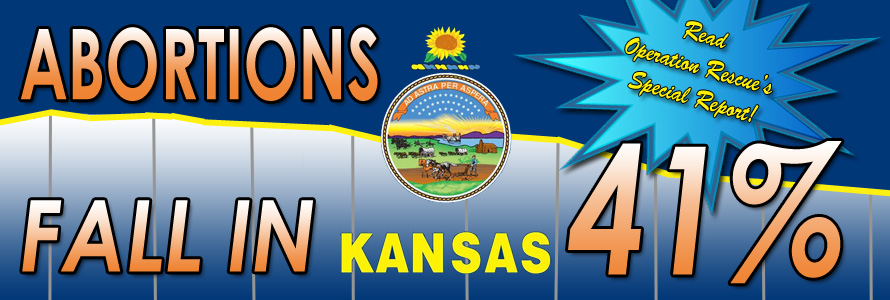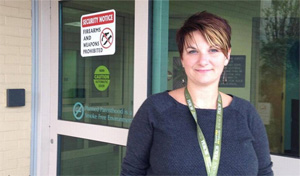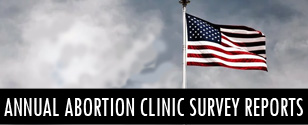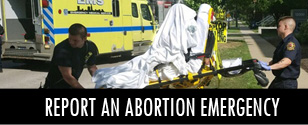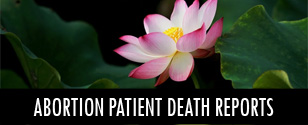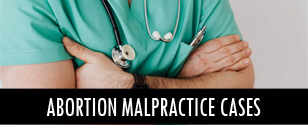An Operation Rescue Analysis By Cheryl Sullenger
 Wichita, KS — The recent release of Kansas Abortion Statistics for 2014 show that the number of abortions continue to decline in the state formerly known as the “Late-Term Abortion Capital of America.”
Wichita, KS — The recent release of Kansas Abortion Statistics for 2014 show that the number of abortions continue to decline in the state formerly known as the “Late-Term Abortion Capital of America.”
“Since we have been working in Kansas, abortions have decreased an extraordinary 41 percent. The tactics we developed over the years have been incredibly successful,” said Troy Newman, President of Operation Rescue, who relocated his organization to Kansas in 2002. “The Kansas abortion statistics prove beyond doubt that when abortion clinics close, lives are saved.”
Newman and his colleague, Cheryl Sullenger, have recently released a new book, Abortion Free, that describes their efforts in Kansas to end late-term abortions and details step by step, how pro-life activists can employ similar strategies to make their communities abortion free. They are considered experts in uncovering abortion abuses and using that information to close down abortion clinics.
“Since we began working our plan in Kansas, abortions have steadily declined as abortion clinics closed. This shows that when there are no abortion clinics marketing abortions to pregnant women, the majority are willing to find ways to cope with their challenges in ways that do not involve visits to abortion clinics,” said Newman.
Several notable trends emerge from the 2014 abortion data, specially when taken in context with abortion numbers over past 12 years or more.
Trend 1: Overall abortion numbers continue to decline.
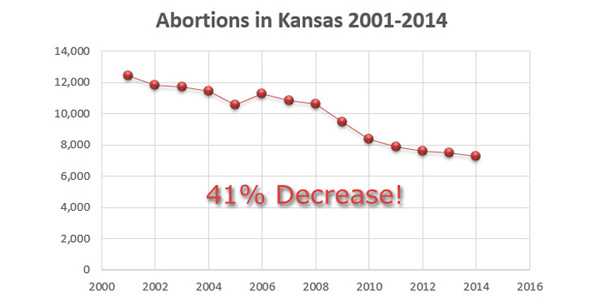
In 2014, the number of abortions in Kansas decreased by three percent over the previous year. This continues a trend of decreasing abortion numbers that began in 2001 when the first of five abortion clinics shut down. Since that year, there has been an impressive 41% decrease in abortions in Kansas.
Pro-life efforts in Kansas to document and expose abortion abuses then pass laws to hold abortionist accountable have been tremendously successful.
Trend 2: When abortion clinics close, abortion numbers drop.

When Operation Rescue first began plans to relocate to Wichita, there were seven abortion facilities in Kansas. Today, there are three. Two are located in Overland Park, near the Greater Kansas City metropolitan area and one is in Kansas’ largest city, Wichita, located in the South Central part of the state.
Abortion clinics shut down in 2001, 2005, 2006, 2009, and 2014. In each case, with one exception, abortions decreased significantly the year following an abortion clinic closure. Decreases ranged from 4-12 percent in years immediately following abortion clinic closures.

For example, abortions dropped 4% after Operation Rescue bought and closed Central Women’s Services in Wichita and transformed the building into its national headquarters. When Tiller’s infamous late-term abortion clinic, Women’s Health Care Services, in Wichita shut down in 2009, there was a remarkable 12% drop in abortions in Kansas.
Although abortions did increase the year after Krishna Rajanna’s appallingly filthy Affordable Medicine Clinic abortion facility in Kansas City closed in 2005, there appears to be other factors involved in the increase, including an adverse political climate that aggressively marketed abortions and vilified pro-life efforts. The increase appears to be an outlier in the overall trend.
Today, there are three remaining abortion facilities in Kansas.
Trend 3: Surgical abortion numbers are dropping while medication abortions are on the rise.
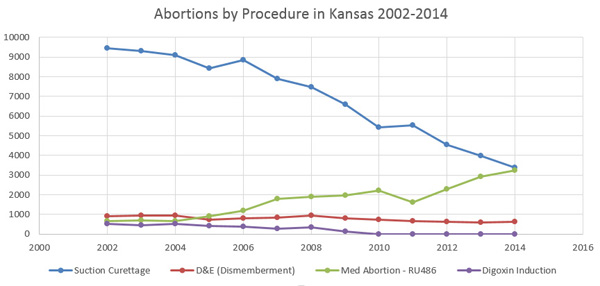
Across the nation, surgical abortions have been decreasing while medication abortions have been increasing in usage. In Kansas, that trend holds true. While medications abortions occupy an ever-growing slice of the abortion pie graph, the size of the pie continues to shrink.
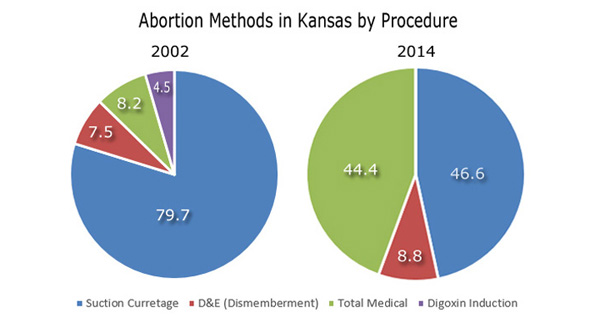
In fact, first trimester abortions in Kansas declined 3 percent in 2014 and have dropped 35 percent since 2002.
In 2002, medication abortions accounted for only 8.2 percent of all Kansas abortions while surgical abortions dominated at 79.7 percent.
By 2014, a substantial change had taken place. Statistics show that medication abortions now comprise 44.4 percent of all abortions in Kansas while surgical abortions have dropped to 46.6 percent of the total.
One of the contributing factors in the dramatic increase in Kansas of medication abortions over the past two years that South Wind has been open, has been the fact that the primary abortionist at South Wind Women’s Center, Cheryl Chastine, is a very inexperienced abortionist who has been more comfortable dispensing medication abortions than conducting the surgical procedures. As a result, medication abortions significantly increased 10 percent last year while surgical abortions fell by 15 percent.
It is likely that medication abortions will surpass surgical abortions when the 2015 numbers come out next spring. Free-standing abortion facilities remain by far the primary distribution source of medication abortions in Kansas.
Trend 4: The late-term barbaric Induction Abortion method has disappeared from Kansas, ending abortions 22 weeks and over.

When Operation Rescue first relocated to Kansas in 2002, there were 528 late-term abortions using George Tiller’s Induction Abortion method. This 3-4 day abortion method was used for the very late abortions for which Tiller was so well known.
It involves injecting the baby in the womb with Digoxin, a drug that causes the baby to suffer cardiac arrest. The woman’s cervix is then dilated and softened over the next day or so. Labor is induced and the dead baby is delivered intact. This is still the preferred method of aborting babies in the late-second and third trimesters in states that still allow this barbaric procedure.
With the closure of Tiller’s Women’s Health Care Services in 2009 and the passage of a 20-week abortion ban in Kansas, Induction Abortions have been eradicated from Kansas with none having been reported in this state since 2011 when two Induction Abortions were the last to be recorded.
Trend 5: The percentage of Kansas abortions involving Dilation and Evacuation, also known as Dismemberment abortions, has held relatively steady in Kansas over the past 12 years.
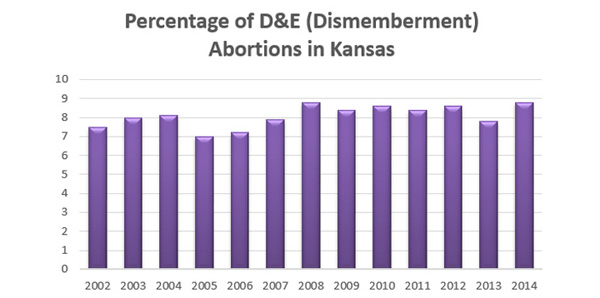
This year, Kansas made headlines by passing the first-in-the-nation Unborn Child Protection from Dismemberment Abortion Act, which criminalized what are known as Dilation and Extraction (D&E) abortions.
D&E abortions are grisly 2-3 day procedures that involve dismembering the pre-born baby with forceps and other instruments in order to remove him or her from the womb.
Statistics show that there has been relatively little change in the percentage of D&E abortions done in Kansas over the past dozen years with the procedure fluctuating only a few tenths of a percent per year. D&E abortions now comprise 8.8 percent of all abortions done in Kansas.
However, in 2014, D&E abortions increased about four percent over 2013 numbers to 637 reported procedures. While the increase is alarming, that number is far from the high number of these barbaric procedures of 933 in 2003.
Thankfully, with this year’s enactment of the ban on dismemberment abortions, we will happily see that number soon drop to zero, barring any legal challenge to the new law.
Trend 6: Abortions on out-of-state women have dramatically decreased.
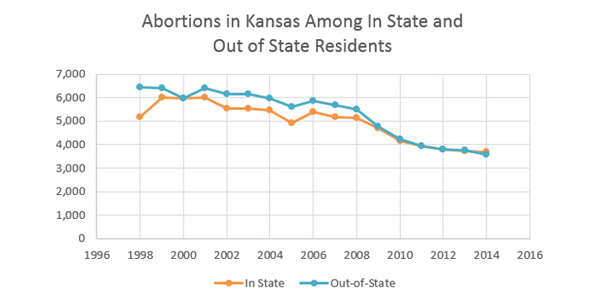
Kansas has traditionally served as an abortion destination state. In fact, for years the number of abortions done on out-of-state residents has exceeded the number of abortions done on Kansas women.
At one time, women from every state came to Kansas for very late-term abortions that were unavailable elsewhere. More recently, since Missouri has only one remaining abortion facility located in St. Louis, women crossed states lines to avail themselves of three abortion facilities that operated in the Kansas City/Overland Park area.
With the 2014 closing of Aid for Women in Kansas City, fewer women are crossing state lines for abortions. Because of that, for the first time since 1998 (the first year stats are available) abortions in Kansas done on out-of-state women have fallen below the number of abortions done on Kansas residents, which is also in steady decline.
Decreasing the number of women crossing state lines to get abortions is yet another example of the benefits of closing abortion clinics.
Trend 7: When counties are abortion free, women living in those counties receive fewer abortions.
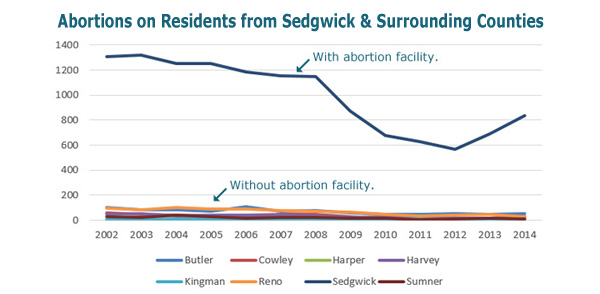
Women who live in counties with no abortion clinics are less likely to get abortions. On the other hand, women who live in counties where facilities are marketing abortions, they are more likely to get them.
This trend shows that, despite the rhetoric from the abortion cartel, women simply do not need abortions. In fact, there has never been even one abortion reported in Kansas done to save a woman’s life. Abortions are medically unnecessary!
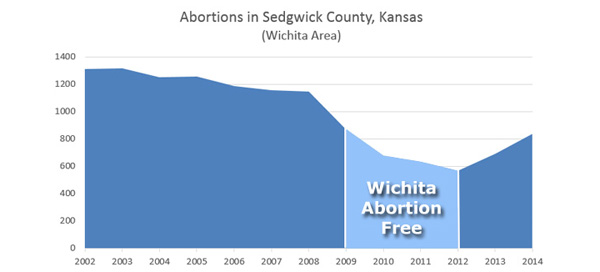
Sedgwick County (Wichita) statistics are revealing on this point.
Abortion numbers took a dramatic drop in 2009 when George Tiller’s Women’s Health Care Services was open for only five months before closing permanently on June 1. Wichita remained abortion-free until April 2013, when South Wind Women’s Center opened for business in Tiller’s old abortion clinic, which sat vacant for nearly four years.
In 2008, the last full year Tiller’s clinic was open, 1146 Sedgwick County residents obtained abortions. By 2012, that number had fallen to 566 – a stunning 51% decrease in abortions among Sedgwick County residents!
What did women in Sedgwick County do when there was no longer a local clinic marketing abortions to them? A good number of those women simply did not have them.
But if women truly needed abortions, the number of Sedgwick County women seeking the procedure would have remained stable when the last abortion facility closed. Clearly, that was not the case.
This debunks the notion that when abortion clinics close, women will just travel elsewhere to get them.
Since South Wind Women’s Center opened in 2013 and began marketing abortions to women, the number of abortions among Sedgwick County women has risen 32 percent over the past two years for which numbers are available, even while abortions numbers continued to drop in other Kansas Counties.
Marketing creates an artificial “need” for a product that is being sold. When the product is abortion, the results become tragic. Without abortion marketing, most women find that the “need” for abortion simply does not exist.
“In Kansas, we have eliminated abortions after 22 weeks, banned two abortion procedures, closed five abortion clinics, and decreased the total number of abortions by forty-one percent. Our tactics have worked and this data supports that,” said Newman.
To learn more about how to make your community abortion free, please read Abortion Free by Newman and Sullenger, available on Amazon.com, BarnesandNoble.com, and WND.com.
View the full 2014 Abortion Report from the Kansas Department of Health and Environment.
All Charts by Operation Rescue
Dramatic 41% Abortion Drop in Kansas Reveals Seven Trends
